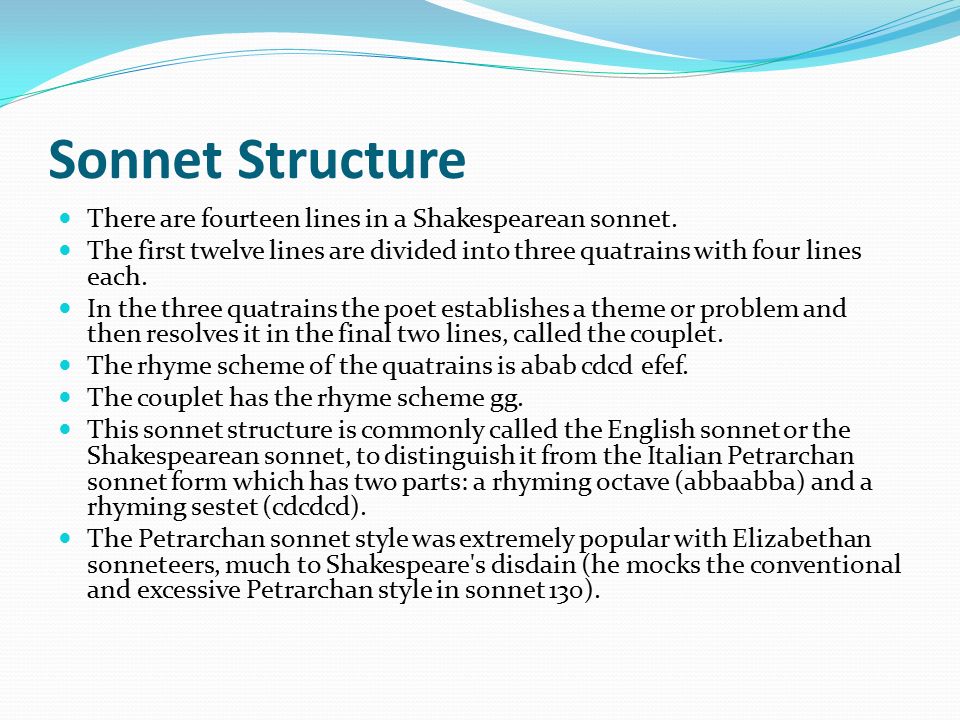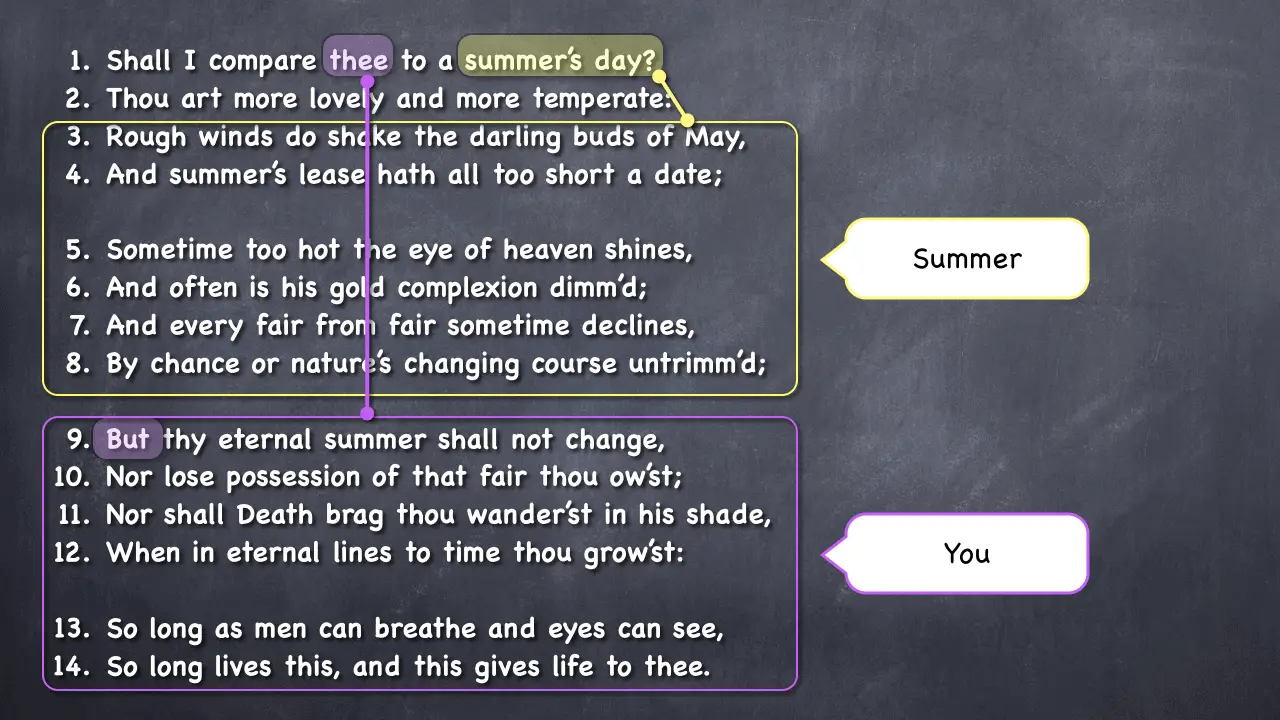
Sonnets have been a cornerstone of poetic expression for centuries, offering a structured yet flexible form that allows poets to explore themes of love, mortality, nature, and philosophy. Their carefully measured lines and rhythmic flow create a harmonious balance between emotion and intellect, making them one of the most enduring forms of poetry.
This guide explores the structure, rhyme schemes, and functional elements of sonnets, breaking down their various forms and stylistic nuances to help poets, students, and literature enthusiasts understand and appreciate the depth of this timeless poetic form.
What is a Sonnet?

A sonnet is a 14-line poem traditionally written in iambic pentameter, often dealing with personal or philosophical themes. The sonnet is distinguished by its formal structure, including specific rhyme schemes and volta (the thematic shift or “turn”) that adds depth and movement to the poem.
Sonnets originated in Italy during the 13th century and were later adapted by English poets, giving rise to distinct Italian (Petrarchan), English (Shakespearean), and Spenserian sonnet forms.
The Core Elements of a Sonnet
Every sonnet follows a few fundamental principles:
A. Line Structure and Meter
✔ 14 lines total
✔ Typically written in iambic pentameter (ten syllables per line, alternating unstressed and stressed syllables)
Example of iambic pentameter:
“Shall I compare thee to a summer’s day?” (Shakespeare, Sonnet 18)
B. Rhyme Schemes
Each sonnet form follows a unique rhyme pattern, which dictates how lines correspond and connect rhythmically.
C. The Volta (The “Turn”)
The volta, or “turn,” is a shift in theme, argument, or tone, usually occurring at line 9 (in Italian sonnets) or line 13 (in English sonnets).
The Three Major Types of Sonnets
A. The Italian (Petrarchan) Sonnet
The Petrarchan sonnet (named after the Italian poet Francesco Petrarca) follows a two-part structure:
- Octave (8 lines) – Introduces the theme, problem, or argument.
- Sestet (6 lines) – Provides a resolution, counterpoint, or response.
✔ Rhyme Scheme: ABBAABBA (Octave) + CDECDE or CDCDCD (Sestet)
✔ Volta: Typically occurs at line 9
Example: Petrarch’s Sonnet 292
“The eyes I spoke of once in words that burn”
“The arms and hands and feet and lovely face”
This form creates a logical division where the first section poses a question or conflict, and the second section provides a resolution.
B. The English (Shakespearean) Sonnet
The Shakespearean sonnet is more linear than the Italian form, consisting of three quatrains (4-line stanzas) and a final rhyming couplet.
- Rhyme Scheme: ABABCDCDEFEFGG
- Volta: Usually appears in the final couplet (lines 13-14)
- Function: Builds a theme or idea through three variations, concluding with a powerful resolution in the couplet
Example: Shakespeare’s Sonnet 130
“My mistress’ eyes are nothing like the sun;”
“Coral is far more red than her lips’ red;”
“If snow be white, why then her breasts are dun;”
“If hairs be wires, black wires grow on her head.”
Here, Shakespeare sets up a humorous critique of poetic exaggeration in the quatrains, before resolving in the couplet with an unexpected declaration of love.
C. The Spenserian Sonnet
Developed by Edmund Spenser, this variation links the quatrains together with interlocking rhyme patterns.
- Rhyme Scheme: ABABBCBCCDCDEE
- Volta: Often at line 9 or the final couplet
- Function: Creates a flowing progression of ideas rather than a strict division like the Petrarchan sonnet.
Example: Spenser’s Sonnet 75
“One day I wrote her name upon the strand,”
“But came the waves and washed it away.”
This form enhances continuity, creating a more fluid narrative or argument throughout the sonnet.
Function and Purpose of Sonnets
A. Themes Commonly Explored in Sonnets
- Love & Beauty – Shakespeare, Petrarch, and Sidney often idealized lovers.
- Mortality & Time – Sonnets frequently contrast fleeting youth with enduring poetry.
- Philosophy & Nature – The Petrarchan tradition reflects on spiritual or existential concerns.
B. The Emotional and Intellectual Impact of the Sonnet
✔ The rigid structure forces discipline, making it ideal for crafting concise yet deeply impactful poetry.
✔ The volta provides contrast, which keeps the reader engaged and surprised.
Writing Your Own Sonnet: A Step-by-Step Guide
A. Choosing Your Theme
- What idea, emotion, or argument do you want to explore?
- Consider contrast (love vs. loss, nature vs. time, hope vs. despair).
B. Structuring Your Sonnet
- Select a Sonnet Form – Italian, Shakespearean, or Spenserian.
- Write in Iambic Pentameter – Maintain the unstressed/stressed pattern.
- Craft a Strong Volta – Introduce a shift in tone, argument, or perspective.
Example: A Shakespearean Sonnet on Time and Memory
(Q1 – Introduces Theme)
“The waves erase the footprints from the shore,”
“And time consumes the words we leave behind;”
“Yet whispers of the past still echo more,”
“As fleeting moments live within the mind.”
(Q2 – Expands Theme)
“The books grow old, their pages lined with dust,”
“But memories, like embers, softly glow;”
“What fades to sight, the heart will hold in trust,”
“A fire that time and tide cannot bestow.”
(Q3 – Presents Contrast)
“Yet winds will change, and voices soon grow weak,”
“The shadows stretch as daylight starts to fade;”
“Though all we cherish fights to stay unique,”
“The course of fate is never long delayed.”
(Final Couplet – The Turn and Resolution)
“But if these lines survive beyond my breath,”
“My voice defies the quiet hands of death.”
Conclusion: The Lasting Power of Sonnets
Sonnets continue to be one of the most dynamic and influential poetic forms, cherished for their precision, elegance, and depth. Whether following the Italian, English, or Spenserian structure, the sonnet’s form demands both technical mastery and emotional depth.
By understanding its structure, function, and variations, poets can craft timeless verses that continue to resonate across centuries. So, pick up your pen, choose your theme, and begin your own journey into the art of the sonnet! ✍️✨
#Sonnets #Structure #Structure of Sonnets
Related Posts
 Fasilitas Kampus: Fondasi Penting dalam Pengalaman Belajar Mahasiswa Modern
Fasilitas Kampus: Fondasi Penting dalam Pengalaman Belajar Mahasiswa Modern
 Classroom Learning: Fostering University Knowledge Acquisition Through Real Experiences
Classroom Learning: Fostering University Knowledge Acquisition Through Real Experiences
 Fisika Modern: Menyingkap Rahasia Alam Semesta dengan Perspektif Mahasiswa
Fisika Modern: Menyingkap Rahasia Alam Semesta dengan Perspektif Mahasiswa
 Self Determined Learning: Menyelami Manfaat Pembelajaran Mandiri
Self Determined Learning: Menyelami Manfaat Pembelajaran Mandiri



